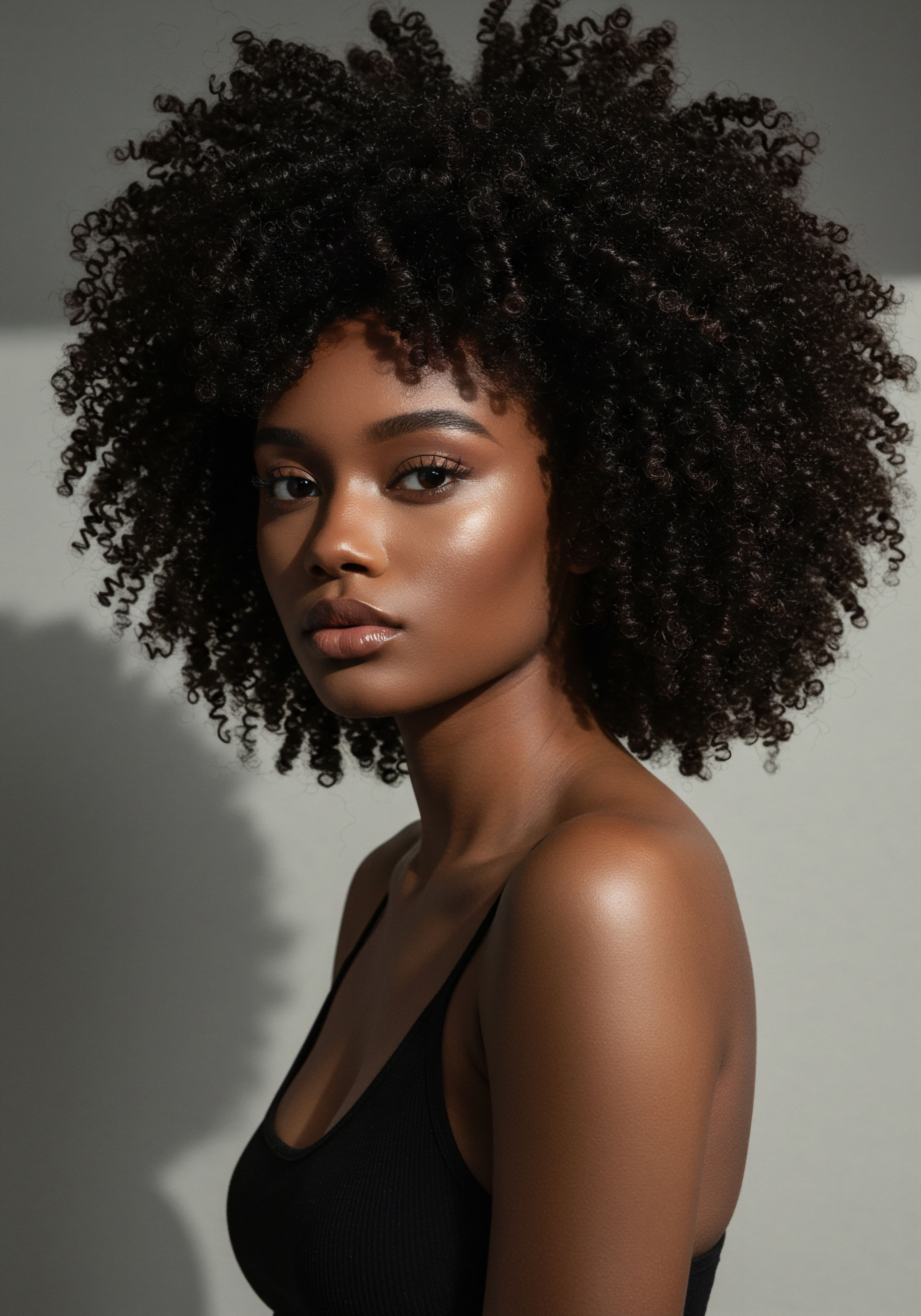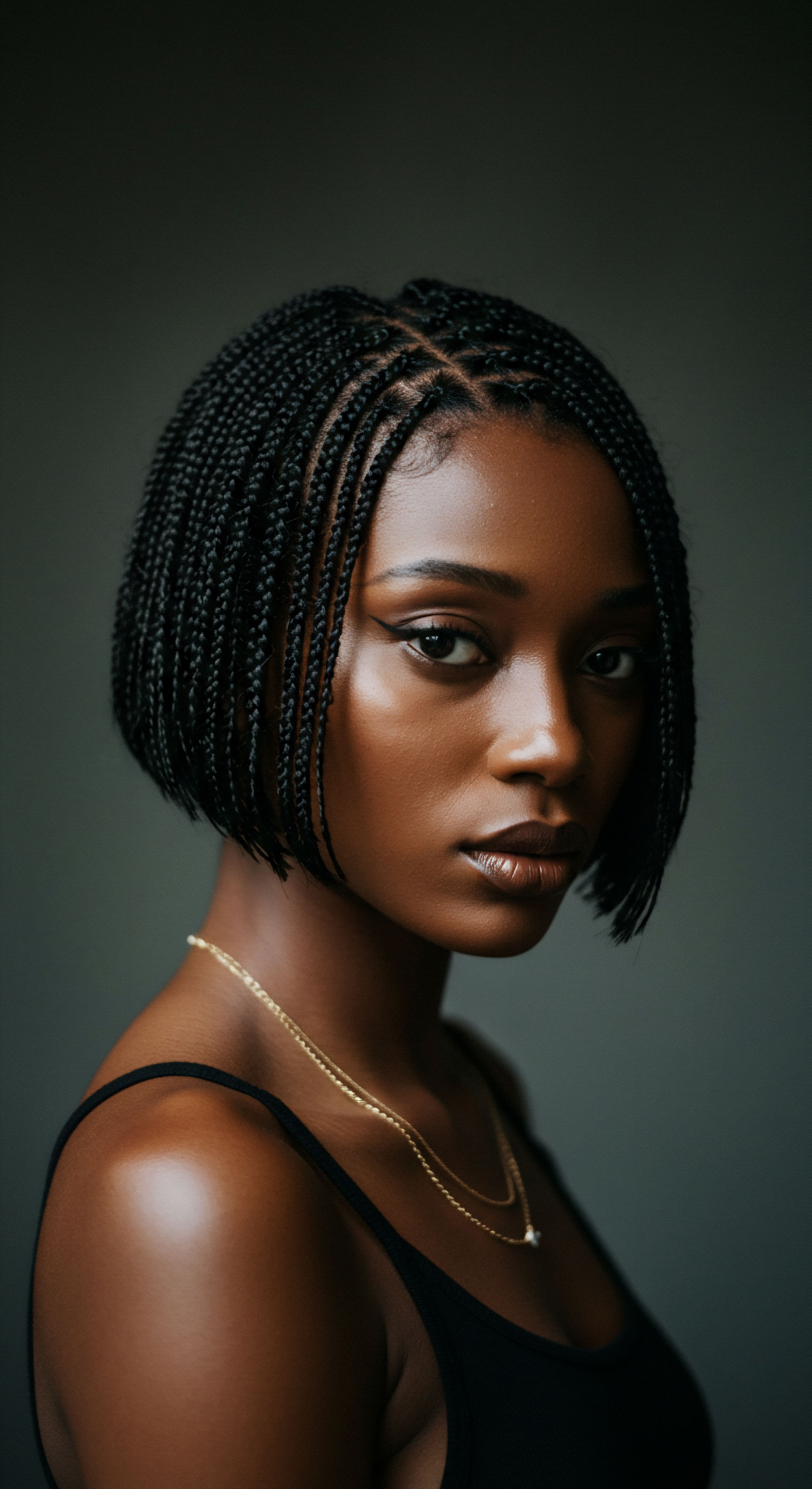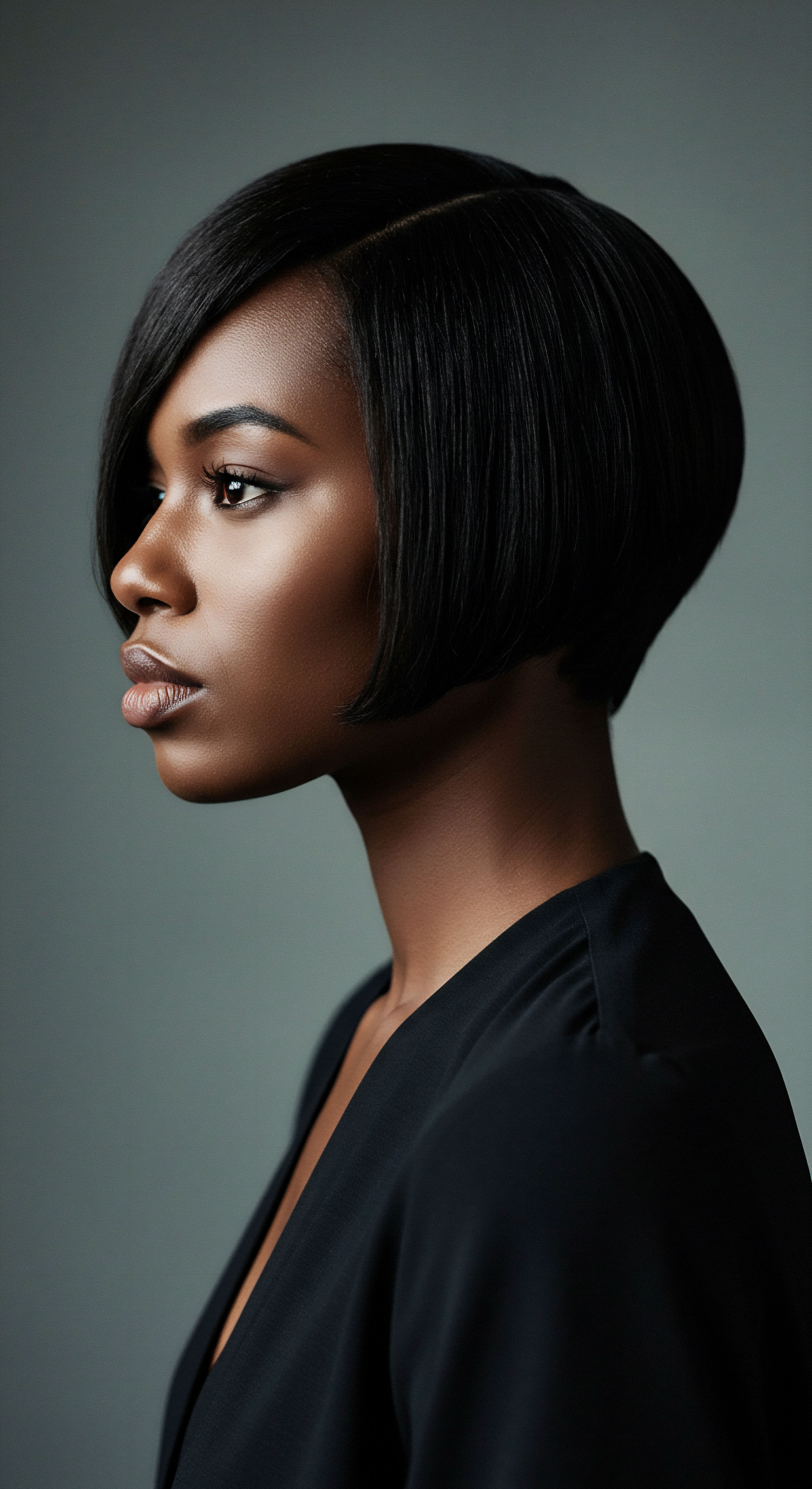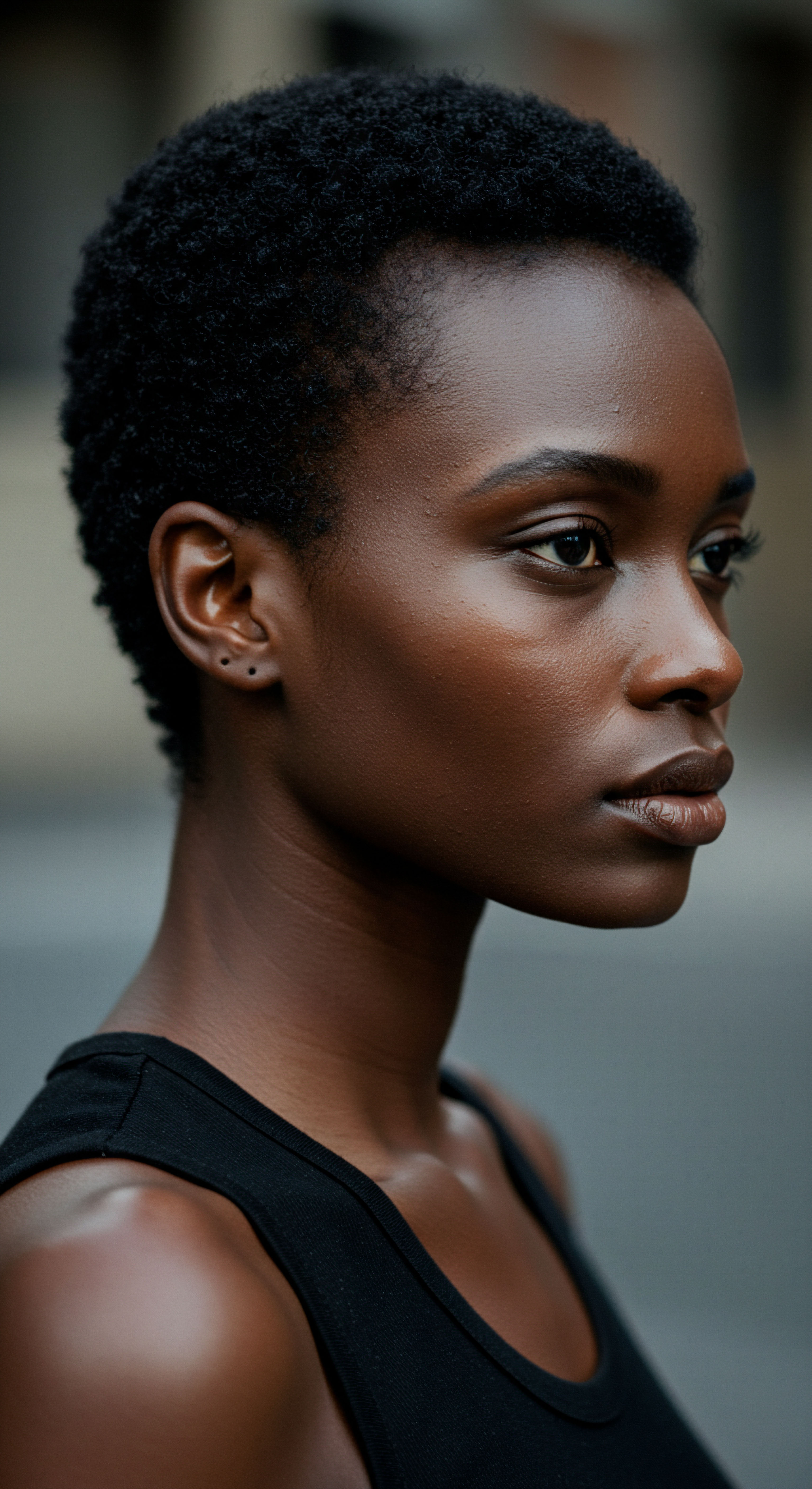
Roots
The journey into understanding hair oils begins not with a product, but with the very essence of a strand itself. Picture a single hair, not merely as a decorative adornment, but as a complex biological wonder, a testament to nature’s design. Within its delicate structure lie the secrets to its resilience, its spring, and its thirst.
For those with textured hair, this understanding carries an added layer of significance, for the unique architecture of each coil and curl dictates how it interacts with the world around it, especially with the nourishing touch of oils. Our exploration here seeks to unearth these fundamental connections, starting with the hair’s own built-in defenses and how fatty acids step onto this stage.

Hair’s Natural Defenses
At its core, hair is a marvel of protein, primarily keratin, organized into a highly specialized structure. The outermost layer, the Cuticle, acts as the hair’s primary shield, composed of overlapping, scale-like cells. These scales, much like shingles on a roof, lie flat in healthy hair, providing a smooth surface that reflects light and minimizes friction. Beneath this protective layer lies the Cortex, the hair’s main body, responsible for its strength, elasticity, and color.
Even deeper, some hair types possess a central core, the medulla. Integral to the cuticle’s integrity and the hair’s overall health is its natural lipid content, a subtle, yet mighty, shield. These lipids, including fatty acids and ceramides, form a protective barrier, reducing water loss and helping to maintain the hair’s suppleness.
Hair, a complex biological wonder, possesses a cuticle of overlapping scales and a cortex of protein, all safeguarded by natural lipids, including fatty acids.

The Fatty Acid Blueprint
Fatty acids, the building blocks of many oils, are organic molecules composed of carbon chains with a carboxyl group at one end. Their diversity stems from the length of these carbon chains and the presence or absence of double bonds within them. This molecular architecture dictates their properties, including their ability to interact with and penetrate the hair fiber. We categorize them broadly:
- Saturated Fatty Acids ❉ These possess carbon chains with only single bonds, allowing for a straight, compact structure. This linearity and smaller size often grant them a unique ability to slip between the cuticle layers.
- Monounsaturated Fatty Acids ❉ These contain one double bond in their carbon chain, introducing a slight bend. This subtle change in shape can influence how they interact with the hair’s surface and their potential for penetration.
- Polyunsaturated Fatty Acids ❉ Characterized by multiple double bonds, these fatty acids have more complex, kinked structures. Their larger size generally limits deep penetration, yet their surface activity holds significant value.
The interaction between these varied fatty acids and the hair’s intricate protein and lipid composition forms the basis of oil’s influence on hair penetration and hydration.

How Fatty Acid Size and Saturation Affect Hair Interaction
The very structure of a fatty acid determines its potential relationship with the hair shaft. Consider a key player, Lauric Acid, a saturated fatty acid found abundantly in coconut oil. Its relatively small molecular size and linear shape allow it to move with ease through the hair’s outer cuticle layers and into the cortex. This deep journey is not merely about adding weight; it helps to fill voids within the hair, reducing protein loss and preventing excessive water absorption, which can lead to swelling and damage, particularly relevant for textured hair that is prone to hygral fatigue.
In contrast, fatty acids with longer chains or those with multiple double bonds, such as linoleic acid, possess a bulkier, less linear structure. This structural difference means they are less likely to penetrate deeply into the hair shaft. Instead, they tend to remain on the surface, forming a protective film. While this surface presence might not be about “penetration” in the same way, it is vital for other aspects of hair health, including sealing moisture and enhancing the hair’s external barrier.
The natural lipids of hair, particularly 18-methyl eicosanoic acid (18-MEA), play a significant part in its hydrophobicity and cuticle integrity. When this natural lipid layer is damaged, whether through chemical processes or mechanical stress, hair becomes more porous and susceptible to water loss. Fatty acids from external oils can help to replenish or mimic these protective lipids, offering a vital layer of defense.

Ritual
The rhythm of hair care, the careful movements of hands tending to coils and curls, is a practice imbued with intention. It is within these rituals that the theoretical science of fatty acids meets the tangible experience of hair hydration. The selection of an oil, the method of its application, and the timing of its presence on the hair are not arbitrary choices; they are deliberate steps influenced by the molecular dialogue between fatty acids and the hair fiber. Here, we step beyond the foundational understanding, exploring how oils, through their fatty acid composition, become active participants in our hair’s daily and weekly needs.

The Spectrum of Oils and Their Fatty Acid Signatures
Hair oils exist on a wide spectrum, each with a unique fatty acid signature that determines its properties and how it serves the hair.
Consider Coconut Oil, often celebrated in textured hair communities. Its dominance of Lauric Acid, a saturated fatty acid with a straight, short chain, grants it a particular affinity for hair proteins. This molecular kinship allows it to readily slip into the hair shaft, helping to reduce protein loss and prevent excessive water absorption.
Then there are oils rich in Oleic Acid, a monounsaturated fatty acid, such as olive oil or avocado oil. While larger than lauric acid, oleic acid still possesses a capacity to interact with the hair, offering a balance between penetration and surface conditioning. These oils can contribute to softness and flexibility.
Oils abundant in Linoleic Acid, a polyunsaturated fatty acid, like sunflower oil or grapeseed oil, typically remain more on the surface. Their larger, less linear structures do not allow for deep penetration into the hair’s core. However, their surface presence is crucial for sealing the cuticle and reducing moisture evaporation.
Different oils, characterized by their unique fatty acid profiles, offer varied benefits, from deep penetration to surface sealing, each serving a specific purpose in hair care.
The table below illustrates the typical fatty acid composition of some common oils and their primary actions on hair:
| Oil Type Coconut Oil |
| Dominant Fatty Acid(s) Lauric Acid (Saturated) |
| Primary Action on Hair Deep penetration, protein loss reduction, reduces water absorption |
| Oil Type Olive Oil |
| Dominant Fatty Acid(s) Oleic Acid (Monounsaturated) |
| Primary Action on Hair Surface conditioning, some penetration, softening |
| Oil Type Avocado Oil |
| Dominant Fatty Acid(s) Oleic Acid (Monounsaturated) |
| Primary Action on Hair Surface conditioning, softening, helps with water retention |
| Oil Type Sunflower Oil |
| Dominant Fatty Acid(s) Linoleic Acid (Polyunsaturated) |
| Primary Action on Hair Surface coating, moisture sealing, adds shine |
| Oil Type Jojoba Oil |
| Dominant Fatty Acid(s) Wax Esters (similar to sebum) |
| Primary Action on Hair Scalp balance, surface conditioning, mimics natural oils |

Does Oil Truly Hydrate Hair, or Just Seal It?
This question lies at the heart of many hair care discussions. True hydration, in a scientific sense, refers to the hair fiber absorbing water. Oils, being hydrophobic, do not inherently add water to the hair. Their primary role in hydration is multifaceted.
First, oils, particularly those that penetrate the hair shaft, can fill the microscopic voids within the cortex. This internal filling can help to make the hair less prone to absorbing excessive water from the environment, which causes swelling and cuticle lifting, especially in textured hair. By reducing this swelling and subsequent contraction (hygral fatigue), oils indirectly help maintain the hair’s internal moisture balance and structural integrity.
Second, and perhaps more commonly understood, oils act as occlusive agents. They form a protective film on the hair’s surface, slowing down the rate at which water evaporates from the hair. This sealing action helps to retain the water already present in the hair, making it feel softer and more pliable. For textured hair, which often has a more lifted cuticle structure, this sealing property is particularly beneficial in preventing rapid moisture loss.
The application of oils, often done after moisturizing the hair with water or a water-based product, creates a barrier that locks in that added moisture. This interplay between water and oil is a cornerstone of effective hydration routines for textured hair.

Application Techniques and Fatty Acid Benefits
The way an oil is applied can influence how its fatty acids impart their benefits. For instance, applying a penetrating oil like coconut oil to damp hair before washing can help reduce the amount of water the hair absorbs during the washing process, minimizing swelling and subsequent damage. This is often referred to as a “pre-poo” treatment.
For sealing, oils rich in larger fatty acids or those that are predominantly non-penetrating are ideal for application to hair that is already hydrated. A light layer can be smoothed over damp strands to create a barrier, holding the moisture within. This method is often part of the “LOC” (liquid, oil, cream) or “LCO” (liquid, cream, oil) methods popular in textured hair care, where the oil acts as the sealant.
Understanding the specific fatty acid profile of an oil allows for a more intentional and effective ritual, moving beyond mere product application to a deliberate act of care grounded in scientific principles.

Relay
Beyond the surface and the routine, the story of fatty acids and hair extends into deeper realms, touching upon the very molecular dance that defines hair health and the cultural practices that have long honored its significance. Here, we peel back layers to uncover the intricate mechanisms at play, acknowledging that the interaction of oils with textured hair is a conversation between science and heritage. This conversation reveals not just what happens, but why it matters, challenging simplistic views and offering a more complete understanding.

The Molecular Mechanics of Penetration and Retention
The journey of fatty acids into the hair shaft is a subtle ballet of molecular attraction and structural fit. Hair, primarily protein, carries a slight negative charge on its surface, especially when wet or damaged. Saturated fatty acids, particularly those with shorter chains like lauric acid, possess a linearity and a slight positive charge on their carboxyl end, allowing them to align with and slip through the spaces between the cuticle cells. This alignment is facilitated by the hair’s natural swelling in water, which gently lifts the cuticle scales.
Once inside the cortex, these fatty acids can interact with the internal keratin proteins. This interaction helps to plasticize the hair, making it more flexible and less prone to breakage. Furthermore, by occupying space within the hair fiber, they reduce the hair’s capacity to absorb excessive water, mitigating the effects of hygral fatigue – the cycle of swelling and shrinking that weakens hair over time. This internal fortification is a key aspect of how certain oils contribute to hair strength and resilience.
The retention of these fatty acids within the hair is also a critical factor. Unlike superficial coatings that can be easily washed away, penetrating oils remain within the hair shaft, offering lasting benefits even after shampooing. This sustained presence contributes to the hair’s long-term conditioning and protection.

Beyond Penetration ❉ The Role of Barrier Integrity
While the deep journey of smaller fatty acids into the hair shaft often captures our attention, quieter scientific whispers remind us of the equally profound work happening on the surface. Research suggests that polyunsaturated fatty acids, particularly those rich in Linoleic Acid, despite their larger molecular size, contribute significantly to the hair’s external lipid barrier. This barrier plays a crucial role in reducing protein loss from the hair fiber, offering a protective shield against daily aggressors and environmental stressors. This protection extends beyond simple absorption, speaking to the hair’s enduring strength.
Consider a study examining the effect of various oils on hair damage. While coconut oil, rich in lauric acid, was found to reduce protein loss significantly by penetrating the hair shaft, sunflower oil, abundant in linoleic acid, did not show the same deep penetration or direct protein loss reduction in the same manner. However, other research highlights the importance of linoleic acid in maintaining the skin barrier, and by extension, the scalp and hair’s external lipid layer.
This indicates that while it may not penetrate deeply to prevent protein loss from within, its role in surface integrity is paramount for overall hair health and preventing damage from the outside. The protective film it forms helps to seal the cuticle, minimizing friction and creating a smoother surface.
The fatty acid story encompasses both deep penetration and surface barrier reinforcement, each vital for hair’s strength and moisture balance.

How Do Fatty Acids Address Textured Hair’s Unique Needs?
Textured hair, with its distinctive coil patterns, presents specific considerations for oil penetration and hydration. The natural bends and twists in textured hair mean that the cuticle layers, which are the hair’s outermost protective scales, may be more lifted or less tightly aligned at certain points along the strand. This structural characteristic can make textured hair more prone to moisture loss and mechanical damage.
This is where the dual action of fatty acids becomes particularly relevant. Penetrating oils, by reducing the hair’s capacity to swell and by strengthening the internal structure, can help to stabilize the hair fiber, making it more resilient to the stresses of daily styling and environmental humidity. For example, a study showed that while external molecules diffuse more homogeneously in straight hair, textured hair’s unique structure influences how oils interact with it.
Furthermore, the surface-acting fatty acids create a crucial external shield. This protective layer helps to smooth the lifted cuticles, reduce friction between individual strands, and seal in vital moisture, preventing the rapid drying that textured hair often experiences. The proper balance of both penetrating and sealing oils, guided by their fatty acid profiles, is therefore not just a preference, but a strategic approach to maintaining the vitality and integrity of textured hair.

Cultural Significance of Hair Oiling Practices
Beyond the molecular science, the practice of oiling hair carries deep cultural resonance across various traditions, particularly within communities with textured hair. For generations, oils have been more than just cosmetic agents; they have been symbols of care, protection, and connection to heritage. From ancestral practices in African communities to the long-standing traditions in South Asia, oiling hair has been a ritual passed down through families, signifying wellness and beauty.
These traditions often recognized, through observation and experience, the very benefits that modern science now attempts to quantify. The shine, the softness, the reduced breakage – these were tangible outcomes of consistent oil application. The selection of specific oils, often local to the region, meant an intuitive understanding of their properties, even without knowing the precise chemical names of their fatty acids. The ritual of oiling, whether a pre-wash treatment or a daily application, served not only a functional purpose but also a communal and personal one, strengthening bonds and affirming identity.
This historical perspective reminds us that while scientific inquiry provides invaluable insights, the wisdom embedded in cultural practices has long held keys to hair health, often predating our molecular understanding.

Reflection
Our journey through the world of fatty acids and their dance with hair reveals a landscape far richer than simple absorption. It speaks to the hair’s quiet strength, its inherent design, and the thoughtful ways we can support its well-being. From the precise molecular fit of a saturated fatty acid slipping into the hair’s core to the expansive shield formed by polyunsaturated lipids on its surface, each plays a vital part in the symphony of hydration and resilience.
For textured hair, these insights hold particular meaning, offering pathways to care that honor its unique structure and its profound cultural stories. As we move forward, may our hands be guided by knowledge, our choices by intention, and our hearts by the enduring beauty of every coil and curl.

References
- Rele, A. S. & Mohile, R. B. (2003). Effect of mineral oil, sunflower oil, and coconut oil on prevention of hair damage. Journal of Cosmetic Science, 54(2), 175-192.
- Gavazzoni Dias, M. F. R. (2015). Hair cosmetics ❉ An overview. International Journal of Trichology, 7(1), 2–15.
- Bouillon, C. & Wilkinson, J. (Eds.). (2005). The Science of Hair Care (1st ed.). CRC Press.
- Keis, K. Persaud, D. Kamath, Y. K. & Rele, A. S. (2005). Investigation of penetration abilities of various oils into human hair fibers. Journal of Cosmetic Science, 56(5), 283-295.
- Robbins, C. R. (2012). Chemical and Physical Behavior of Human Hair (5th ed.). Springer.
- Khumalo, N. P. Gumedze, F. N. & Ngwanya, R. M. (2000). Ethnic Hair ❉ A Review of Structure and Properties. Journal of Cosmetic Science, 51(6), 379-391.
- Lacerda, L. G. G. de, Soares, R. B. P. & da Silva, V. R. (2021). A review of the effects of oils on hair fiber. Journal of Cosmetic Dermatology, 20(2), 373-380.
- Wang, X. Jia, Y. & He, H. (2025). The Role of Linoleic Acid in Skin and Hair Health ❉ A Review. Cosmetics, 12(1), 26.
- Bauer, J. E. (2008). Update on the effect of dietary fatty acids on skin and hair coat. Veterinary Clinics of North America ❉ Small Animal Practice, 38(3), 633-644.
- Orfanos, C. E. & Happle, R. (Eds.). (1990). Hair and Hair Diseases. Springer-Verlag.
- Maymone, M. B. C. Laughter, M. & Vashi, N. A. (2021). Hair Aging in Different Races and Ethnicities. The Journal of Clinical and Aesthetic Dermatology, 14(1), 37-44.
- Sharma, S. & Mohile, R. B. (2010). Hair Oils ❉ Indigenous Knowledge Revisited. International Journal of Trichology, 2(1), 28-30.
- Gubitosa, J. Rizzi, V. Fini, P. & Cosma, P. (2019). Physicochemical Aspects of the Performance of Hair-Conditioning Formulations. Cosmetics, 6(1), 16.